Landmarks hosts hearing on towers for 250 Water and the expansion of the Seaport Museum
The Howard Hughes Corporation’s proposal for 250 Water went before the Landmarks Preservation Commission on Tuesday, and to give you a sense of what kind of impact this is having on neighbors, the hearing ran for nine hours and 140 people signed up to speak — and this does not count the pages of testimony presented in advance. There’s a lot to unpack here, not just because of the history of the district (the birthplace of New York City!) but also the modern history of the site itself, which has been a parking lot since the ’70s as well as the subject of nine failed proposals, and the most recent plan to frame it as the savior of the South Street Seaport Museum.
To start: there’s no doubt that this site should be developed. I for one will never advocate for preservation when it comes to a parking lot. Empty lots destroy the city’s fabric. However, the height of the towers — 470 feet — seems to be getting obscured in a preservation smokescreen, and advocates for the proposal are framing it as an all-or-nothing deal: take it, or the whole neighborhood dies. You don’t need to be a strident preservationist to agree that the proposed height is not appropriate for a historic district. And how could this not be precedent setting for our other downtown historic districts?
But this proposal may indeed be moving forward, if the temperature of the virtual hearing room was any indication. There is not only a groundswell of enthusiasm for the project from the city’s real estate media (Crain’s, The Post, and in a roundabout way, Gothamist) but also from local elected officials — both Gale Brewer and Margaret Chin testified in favor. And as the supreme coda, the city historian Kenneth Jackson gave his blessing. He argued that buildings of this size aren’t tall at all for downtown and that the building wouldn’t even be spotted from the restaurant Manhatta (?!).
With 38 stories planned in its 470 feet, the two towers rise 350 feet beyond what the 2002 rezoning allows, though they would be built on top of what the architects call a contextual podium base — five-story brick facades that do in fact look native to the neighborhood in the renderings. Skidmore, Owings and Merrill have been engaged from the start, and this was one of the best presentations I have ever seen, frankly, for its thoughtful approach to the history of the area and to the quality of each drawing and each frame of the presentation. (I can only imagine what they have spent so far, before one shovel goes in the ground.)
So, more to the details, which go a lot further than previous presentations: With the development of 250 Water will come a renovation of the museum’s current structure and a build out of a new building on another empty lot, at South and John. The new building gets the full treatment in the proposal — actually a more thorough one than the 250 Water buildings itself. Some key elements of the two proposals:
> 175 John (aka 89 South) will be built out for the museum
> the material will be copper, which will eventually turn green!
> the Seaport Museum galleries will be completely renovated (more on the museum soon)
> the 250 Water site will be on a contextual (five-story) podium base, building out the streetscape that has been empty for five decades
> the materials will be contextual brick
> the towers are also masonry with decks on some units
There will be a total of 360 units, 100 of which will be affordable at 40 percent of median income, which is a little less than $41,000 for a family of three.
There is still a lot of local opposition from the community-led Seaport Coalition and CB1. And there is a lot more to do for the developers: the Landmarks Commission will make its decision on Jan. 12 in a public zoom meeting; the city’s land use process will start later this year.
I have assembled just a few of the images from the presentation; if you want to watch it for yourself, see it here on the LPC’s YouTube channel. Some helpful markers, with the 4-minute video being the most efficient if you are pressed for time:
- HHC’s intro: 0:36
- general project plan from SOM: 0:45
- presentation on the museum: 1:02
- presentation on 250 Water: 1:25
- 4-minute rendering video that walks through the neighborhood (amazing tech): 1:55
- testimony starts at: 2:33







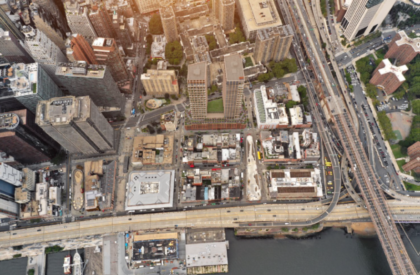
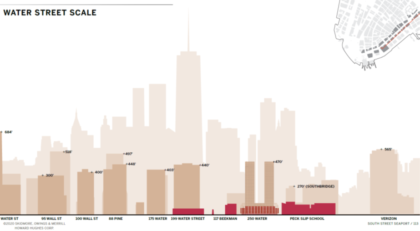
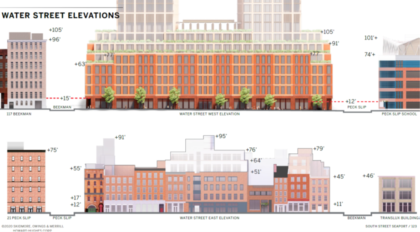
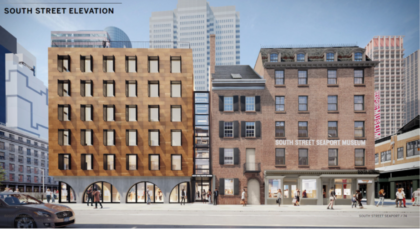
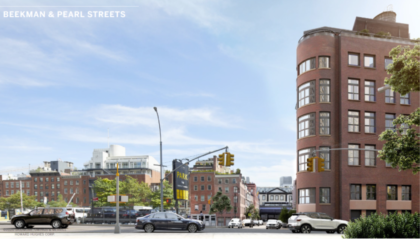
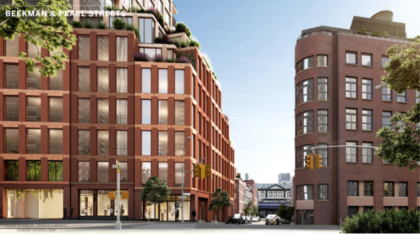
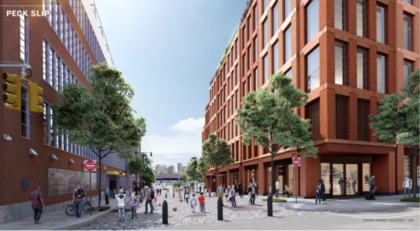
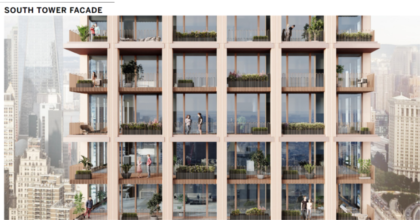
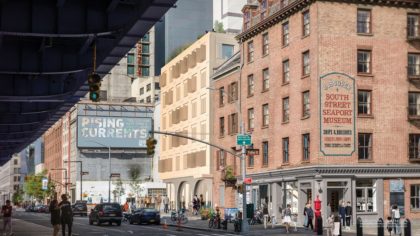
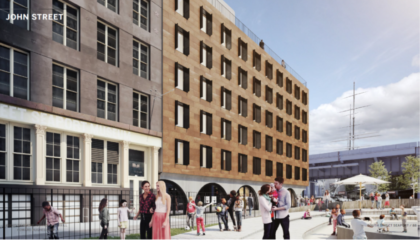
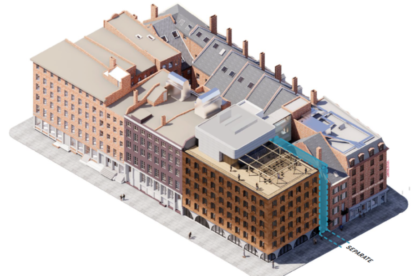






while the area improvements are needed and beneficial, and the design esthetically pleasing, the towers are huge, and more interestingly half of the FAR being used to build these towers come from Pier 17. Since we approved, recently, selling airrights from pier40 to make money for the hudson river park, this notion of grabbing airrights from piers is becoming acceptable. Since the city owns these airrights, how much is Hughes paying for them? And does this mean we will sell other phantom airrights from piers to build more towers near the water? And the community board was overhwelmingly against this project – see their november 2020 meeting. Interesting change of direction.
What is sad is that the groundswell is from the Real Estate Community and those financially connected to HHC. The community around and within the Historic District in a 3:1 margin opposed the towers. The Borough President only wants to save the museum and made that clear – quid pro quo. The museum has struggled for a decade and they continued to pursue the same path. This is a huge price tag to pay for a sinking ship.
CM Chin has failed to secure the affordable housing that existed in the district when she took office – she has seen thousands of units expire and disappear. Why is it now that she wants to add 100 when she did not advocate to save thousands of affordable housing units during her tenure. Where are the calls and pushes for 5 WTC to be affordable housing? This is a sell out to save a failing museum and will set precedent for every historic district.
It is quite misleading to say there is a groundswell of support when over 7,500 petitions have been signed, with over 200 comments from residents, visitors, ex-NYers, nautical enthusiasts, and preservationists from all parts of the world.
99% of those who are ‘in favor’ are either the RE industry or stand to benefit from this development. They are on HHC payroll, a tenant, a future contractor or the museum itself (Who instead of being against the towers as they were when it was going to go up on Pier 17 – and are now in favor or 250 Water Street twin towers because it comes with a $50 million dollar endowment. In other words, very few if any people are actually in favor of this as a positive addition to the Historic District.
Almost all see it as a dangerous zone busting precedent for all historic districts around the city – a massive structure that would forever negatively change the character of the neighborhood – but they might hold their nose in order to get dubious ‘community benefits’ in the form of money for the Museum.
Landmarks should not be considering anything other than what they are tasked with looking at; the size, bulk, materials, of the building itself. Period. On those grounds it should be an easy “NO”.
Disagree totally. We need more consumers in the region. Half of seaport stores and restaurants closed, many before covid-19. Look to 10 corso Como, Guess, Taco Playa, Big Gay Ice Cream, and many more. Who is against more development in a PARKING LOT is just selfish! Again, this is a PARKING LOT!
Not saying don’t build…build within the allowed zoning…they could put an amazing structure with hundreds of units that fits the area…most of the Seaport stores were supported by the hundreds of thousands of workers from local office towers, businesses and tourism…that needs to return to boost all of Downtown. That’s why businesses are closing left and right…can’t replicate those numbers with one out of scale building.